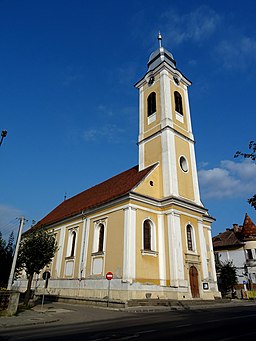Calvinist Small Church
Biserica Reformată Mică
Calvinist Small Church
Biserica Reformată Mică
Address:
Strada Ștefan cel Mare 22 (egykori Gecse Dániel utca)
Historical Hungarian county:
Maros-Torda
GPS coordinates:
46.539770127, 24.5667070606
History
The second Reformed church in the town. From 1628 until the construction of the church, the site of the Small Church was the hospital of the Reformed Church, a building for the shelter and care of the poor and needy. Next to it, in the early 18th century, a Reformed wooden church was erected with the support of the town judge Kolozsvári Szőts Dániel, known locally as the Outer Church or the Hospital Church.
In 1815, the hospital was demolished and the construction of a new late Baroque and Empire style church was started, based on the plans of Sófalvi József, which was completed by 1818. However, due to a lack of funds, the construction was only given a new impetus in 1827, when the interior works were completed. The first service took place on 2 December 1827. In 1828, construction of the tower began and was completed in 1829. It is named after its slightly smaller size than the Castle Church, but it still seats seven hundred.
In August 1854, after the Hungarian War of Independence, it was expropriated by the Austrian military command and used as a military hospital and later as a grain warehouse. The Reformed Church got the building back in March 1856 (the old wooden church was used until then, and was demolished in 1857), and it was reconsecrated by Bishop Bodola Sámuel.
The church also had a Reformed boys' school, and later a mixed school, which initially operated in the rector's apartment. In 1848 there were already 175 pupils, so in the 1850s a separate school building was erected near the church, which was taken over by the town in 1891. At the beginning of the 20th century, during the mayoralty of Bernády György, several new school buildings were erected for the town's pupils, and the former Reformed school was converted into a residential building.
Its organ was made in 1867 by Takácsy Ignác, the altar was donated in 1868 by Szenkovitsné Rákosi Katalin. In 1875 the building was renovated, and the octagonal pulpit and its canopy were erected from the donation of Szöllősi Sámuel and Rozália. Between 1927 and 1930 the church was renovated again, and it acquired its neo-baroque classicist appearance. The widow of Domokos Pál donated a 1t bell to the parish in memory of her husband and sons.
The prominent pastors of the 20th century were Csiha Kálmán (1929-2007) and Varga László (1929-2017). Under communism, they were convicted in show trials and imprisoned for long periods.
Next to the staircase is a metal plate dating from 1902, on which the altitude was recorded: Marosvásárhely free royal town 332,376 metres.
{"item":"sight","set":{"sightId":2293,"townId":85,"active":1,"name_LO":"Biserica Reformat\u0103 Mic\u0103","address":"Strada \u0218tefan cel Mare 22 (egykori Gecse D\u00e1niel utca)","mapdata":"1|2889|3470","gps_lat":"46.5397701270","gps_long":"24.5667070606","religion":2,"oldtype":"1","newtype":"1","homepage":"https:\/\/kistemplom.ro\/","openinghours":"","muemlekemlink":"https:\/\/www.muemlekem.hu\/hatareset\/Reformatus-kistemplom-Marosvasarhely-1803","csemadoklink":"https:\/\/lexikon.adatbank.transindex.ro\/muemlek.php?id=418","picture":"\u003Ca title=\u0022Whitepixels, CC0, via Wikimedia Commons\u0022 href=\u0022https:\/\/commons.wikimedia.org\/wiki\/File:RO_Tg_Mures_Calvinist_church.jpg\u0022\u003E\u003Cimg width=\u0022256\u0022 alt=\u0022RO Tg Mures Calvinist church\u0022 src=\u0022https:\/\/upload.wikimedia.org\/wikipedia\/commons\/thumb\/6\/60\/RO_Tg_Mures_Calvinist_church.jpg\/256px-RO_Tg_Mures_Calvinist_church.jpg\u0022\u003E\u003C\/a\u003E","picture_ref":"\u003Ca href=\u0022https:\/\/commons.wikimedia.org\/wiki\/File:RO_Tg_Mures_Calvinist_church.jpg\u0022\u003EWhitepixels\u003C\/a\u003E, CC0, via Wikimedia Commons","name":"Calvinist Small Church","note":"","history":"The second Reformed church in the town. From 1628 until the construction of the church, the site of the Small Church was the hospital of the Reformed Church, a building for the shelter and care of the poor and needy. Next to it, in the early 18th century, a Reformed wooden church was erected with the support of the town judge Kolozsv\u00e1ri Sz\u0151ts D\u00e1niel, known locally as the Outer Church or the Hospital Church.@\nIn 1815, the hospital was demolished and the construction of a new late Baroque and Empire style church was started, based on the plans of S\u00f3falvi J\u00f3zsef, which was completed by 1818. However, due to a lack of funds, the construction was only given a new impetus in 1827, when the interior works were completed. The first service took place on 2 December 1827. In 1828, construction of the tower began and was completed in 1829. It is named after its slightly smaller size than the Castle Church, but it still seats seven hundred.@\nIn August 1854, after the Hungarian War of Independence, it was expropriated by the Austrian military command and used as a military hospital and later as a grain warehouse. The Reformed Church got the building back in March 1856 (the old wooden church was used until then, and was demolished in 1857), and it was reconsecrated by Bishop Bodola S\u00e1muel.@\nThe church also had a Reformed boys' school, and later a mixed school, which initially operated in the rector's apartment. In 1848 there were already 175 pupils, so in the 1850s a separate school building was erected near the church, which was taken over by the town in 1891. At the beginning of the 20th century, during the mayoralty of Bern\u00e1dy Gy\u00f6rgy, several new school buildings were erected for the town's pupils, and the former Reformed school was converted into a residential building.@\nIts organ was made in 1867 by Tak\u00e1csy Ign\u00e1c, the altar was donated in 1868 by Szenkovitsn\u00e9 R\u00e1kosi Katalin. In 1875 the building was renovated, and the octagonal pulpit and its canopy were erected from the donation of Sz\u00f6ll\u0151si S\u00e1muel and Roz\u00e1lia. Between 1927 and 1930 the church was renovated again, and it acquired its neo-baroque classicist appearance. The widow of Domokos P\u00e1l donated a 1t bell to the parish in memory of her husband and sons.@\nThe prominent pastors of the 20th century were Csiha K\u00e1lm\u00e1n (1929-2007) and Varga L\u00e1szl\u00f3 (1929-2017). Under communism, they were convicted in show trials and imprisoned for long periods.\nNext to the staircase is a metal plate dating from 1902, on which the altitude was recorded: Marosv\u00e1s\u00e1rhely free royal town 332,376 metres.\n&\nwikipedia: Kistemplom (Marosv\u00e1s\u00e1rhely)|https:\/\/hu.wikipedia.org\/wiki\/Kistemplom_(Marosv%C3%A1s%C3%A1rhely)","town":{"townId":85,"name_HU":"Marosv\u00e1s\u00e1rhely","name_LO":"T\u00e2rgu Mure\u0219","seolink":"marosvasarhely-targu-mures","oldcounty":41,"country":4}},"language":"en","region":"romania","regionid":4,"offer":[],"gallery":false,"album":false}

